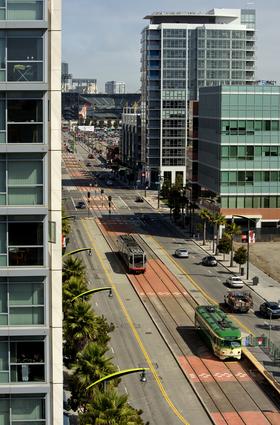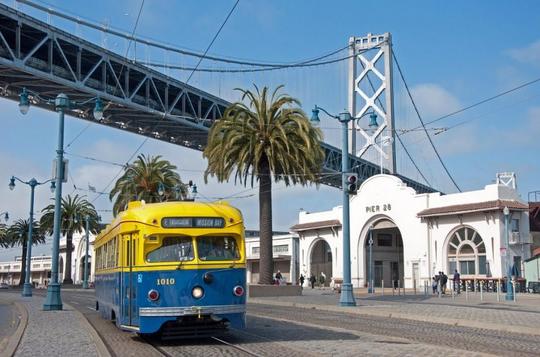Looks like the E-Embarcadero streetcar line had a real coming out party this past weekend.
The Saturday and Sunday service, tied to the America’s Cup World Series races, got lots of attention from folks up and down the waterfront, who realized what PERMANENT E-line service could do to stimulate economic activity and improve transit for residents and visitors alike.
Perhaps the best overall summary came from Nellie Tran on livesoma.com, emphasizing the quality of the vintage streetcars and how well they fit into the modern South Beach/Mission Bay environment:
> “As for my own opinion on the E Line- I think it’d be great to have the E Line connecting this part of town to Pier 39, Fisherman’s Wharf, and beyond. With all the new housing coming up in Mission Bay, Caltrain ridership on the rise, the tech boom, the continuing popularity of AT&T Park, and the potential Warriors Arena, I can easily imagine the E Line getting just as many riders boarding at the stops near the Caltrain and ballpark as there had been near the Ferry Building. It would be a great service to have that direct connection to the northern waterfront.”
With two Giants games during the weekend service, the E-line proved its worth in that capacity, carrying lots of happy fans from the northeastern Waterfront area without having to transfer. It’s easy to see a future symbiotic relationship between Wharf attractions and Giants games, with people coming up from the Peninsula on Caltrain or from the East Bay on BART and using the E-line to “make a day of it” by dining at the Wharf and taking in a game. Same would be true should the Warriors arena on Piers 30-32 come to fruition, of course. As every transit professional knows, convenience and attractiveness is the Holy Grail to attract people from their automobiles onto transit, and the Caltrain/BART-E-line connection would certainly provide that.
More importantly from a city perspective, the E-line service was strongly welcomed by the South Beach-Rincon Hill-Mission Bay neighborhoods. We joined with their neighborhood association to turn out some 30 volunteers to provide information to riders at stops and stations along the E-line, and from the feedback they got, it was much appreciated. Want to add a shout out here to Paul Lucas, our ace volunteer who did a ton of work updating our docent handbook and customizing it for the E-line. Thanks, Paul!
We’ve heard from leaders of the Fisherman’s Wharf Association, the Exploratorium (soon to open at Pier 15), the South Beach-Rincon Hill-Mission Bay Neighborhood Association, UCSF, and others, with words of praise for Muni’s E-line trial, and suggestions for making it even better the next time, during Fleet Week, October 4-8.
Of course, few things work perfectly the first time. On Sunday, there were only four E-line streetcars on the line, instead of the scheduled five, because they ended up a crew short with no backup. As a result, some people waited more than 30 minutes for their ride, while looking at signs predicting service “about every 15 minutes.” And none of the three most historic Muni streetcars, Nos. 1, 130, and 162 (also among the largest capacity streetcars in the fleet) made it out over the weekend, even though significant effort had been expended by Muni to get them ready.
On the other hand, 1948 Muni PCC No. 1008 made its debut after a full restoration, to rave reviews. Here’s a video by volunteer Jamie Whitaker of 1008 passing 1928 Melbourne No. 496, looking right at home at Folsom Station.
Finally, we have to mention how much at home the E-line streetcars looked while they were pulling in and out of service at their weekend home, Metro East. They used the T-line tracks on Third Street to do this. We think it’s a demonstration of how much value there would be in extending the E-line to Pier 70 in Dogpatch, as MSR has long advocated. Here’s a great shot of No. 1008 passing an LRV near the UCSF campus, with AT&T Park in the background.

PCC No. 1008 passes an LRV on the T-line on its way into E-line service on Third Street on the UCSF campus, August 16, 2012. Kevin Sheridan photo. Click to enlarge.
Join us — and volunteer — for the next E-line operation October 4-8.

Congrat’s Rick and all your crew ! I know its a been a long time in the making. Keep your good work.
I wonder why they don’t just make the 4th and King intersection into a wye for turning around the single-ended streetcars. It seems like they would just need to add one short track to turn from westbound 4th to southbound King:
https://maps.google.com/?ll=37.776096,-122.393862&spn=107.74522,191.953125&t=u&z=3&layer=c&panoid=0aeYHKc-MDwrvM4cH12QXw&cbll=37.776096,-122.393862&cbp=13,-394.5387377270846,,0,1.7188733853925555
Something like this is one of the options for the eventual Fort Mason turnaround (vs a loop)
A wye (so named because of the shape of the trackwork) requires a streetcar to back through two switches as part of the reversing process. This works okay off-street or at quiet intersections, but Fourth and King is one of the busiest in the city, for both rubber-tired vehicles and streetcars. Trying to reverse through that intersection would be a nightmare, holding up streetcars on the N and T lines as well as automobiles and trucks. We looked at a wye for the Fort Mason terminal, which is off-street, but it couldn’t come close to handling the volume of streetcars you would need for special events in the exhibition spaces. Loops are far more efficient than wyes, and are vastly preferred by operators as well.